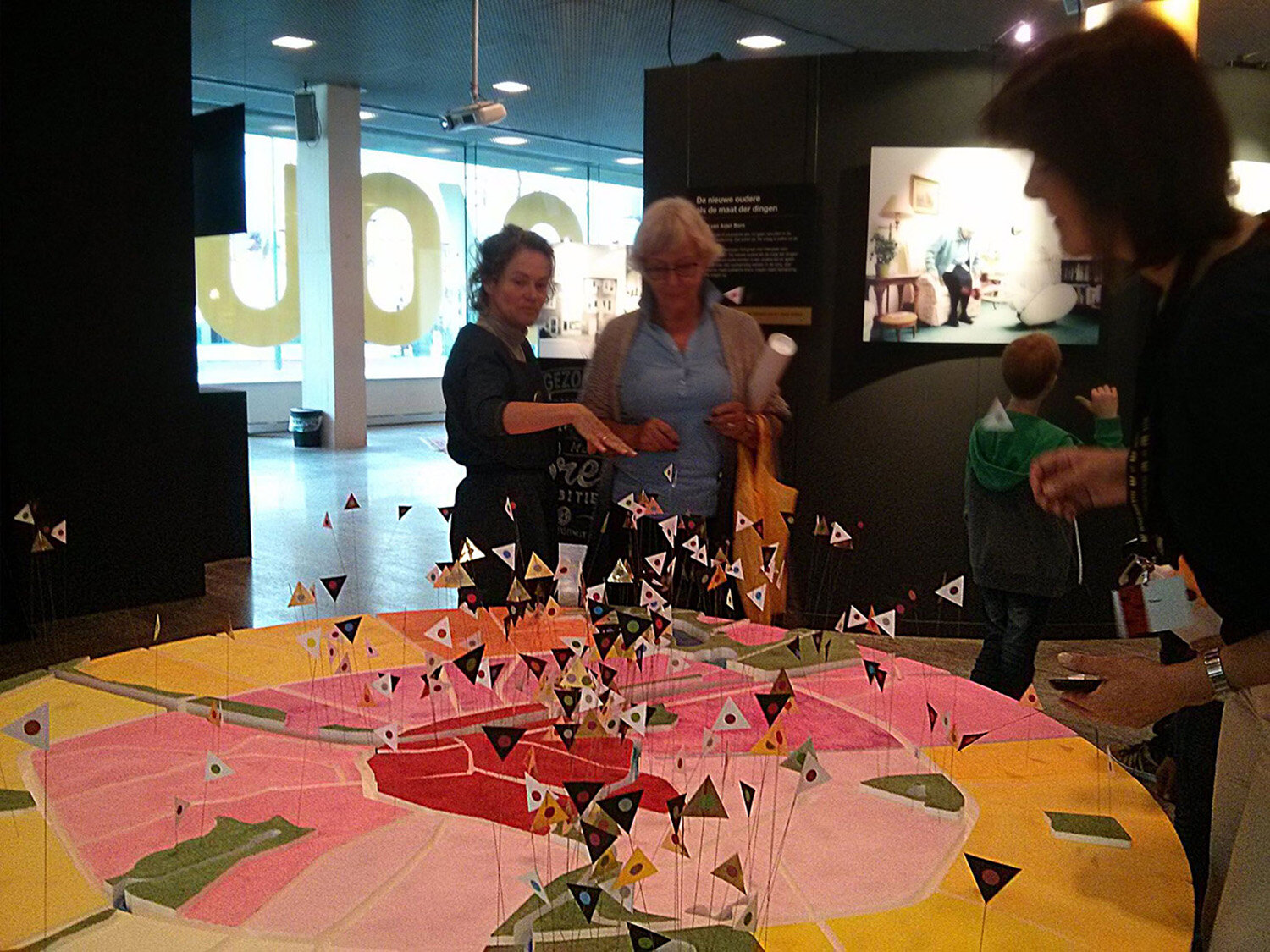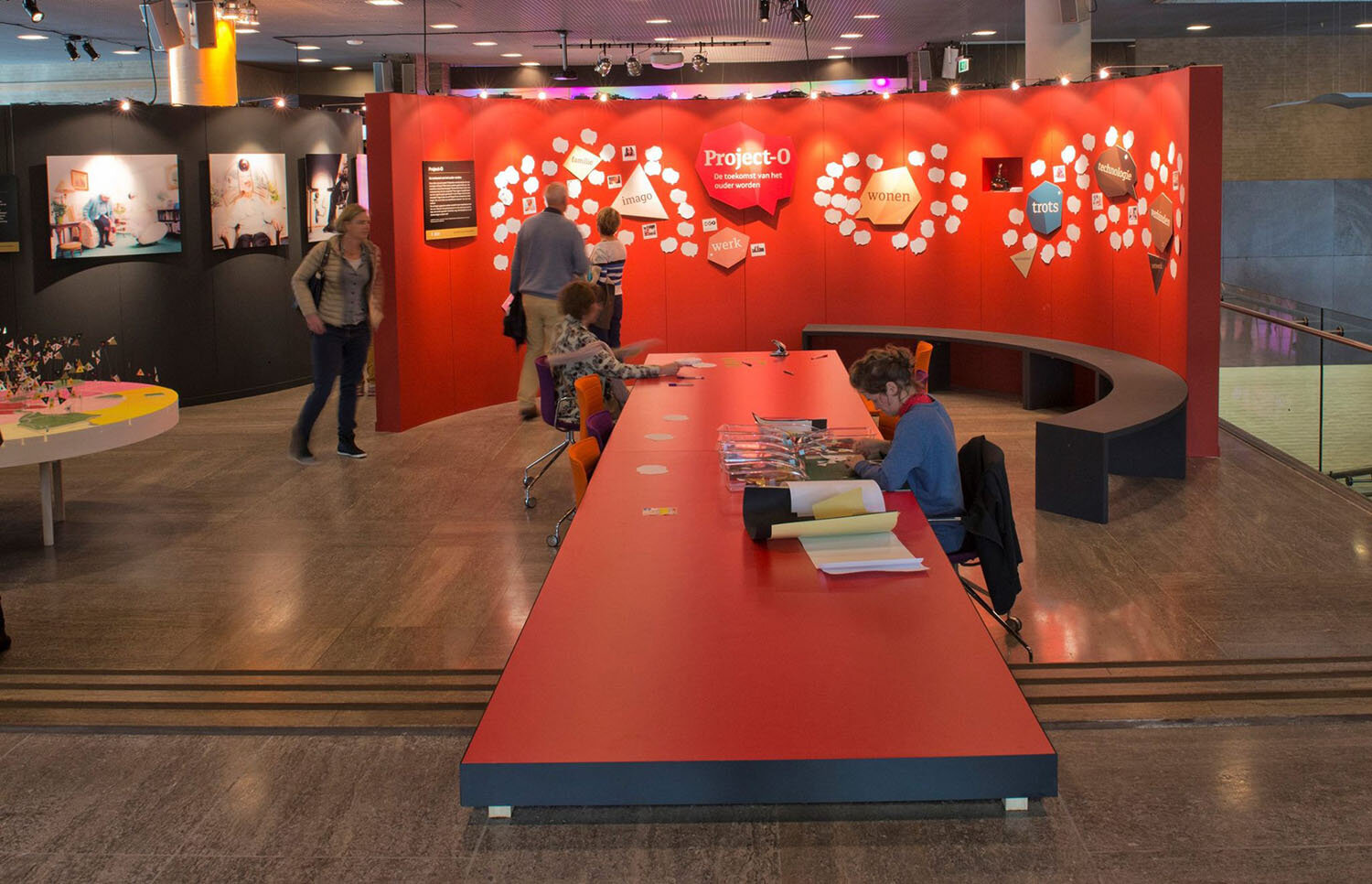ddw 2014
client: Dutch Design Week 2014, g/oud
location: Stadhuisplein 1, Eindhoven
exposition: 2014
pdf, report: Dutch Design Week 2014
Stefan de Bever and Heleen van Heel are principals of the more than 120-year-old family business De Bever architecten bv. After an international and national career, they have given the company a new dimension. They are open to technological developments and new insights in the field of sustainability and design.
In addition, they have founded De Bever architects Eindhoven in 2013 to design special projects. Location-specific workshops and research with students form the basis for the designs. The projects contribute to contemporary and future-oriented issues. Future changes in use, technology, and society are analyzed and incorporated into smart structures that become the basis for the projects.
Project o; they will live long
The map of Eindhoven forms the basis for a 3d infographic about the housing needs of the elderly. Passers-by of all ages are invited to express their living wishes of old age by means of 3 stickers (red, green, gray) to stick on 3 flags (gold, white and black). The flags with stickers may then be placed on the map.
Map of Eindhoven, in which different colors indicate the neighborhoods, parks, roads, rail, and water. The roads are deepened, the greenery raised.
Flags;
Gold = favorite choice
White = neutral choice
Black = least favorite choice
The flags indicate with a blue or pink sticker whether the participant is a woman or a man. The flags have different lengths corresponding to 5 age groups.
10 to 30 year old, 12 cm long
30 to 50 year old, 16 cm long
50 to 70 year old, 20 cm long
70 to 90 year old, 24 cm long
From 90 to …… ....., 28 cm long
Choices regarding housing requirements;
Red = close to family and friends
Green = in green and quiet
Gray = close to amenities
Report;
300 flags have been made in advance for each housing wish, a total of 900 pieces. We have
prepared for 1500 flags and can expand to 3000.
Each participant has 3 flags available. We hope to have about 500 people up to a maximum of 1000 people to participate in the study.
On the first day, it appears that the age groups 50 to 70 years and 70 to 90 years are present a lot. From the first Sunday, we made extra flags for these age groups. The 30 to 50 age group is the least present.
It becomes clear that regardless of age groups and gender, there is a clear preference for living in the center and in and around the parks of Eindhoven.
Photo first day, good to see that the center and parks are preferred.
More flags are made at the places for participants aged 50 to 90.
After 5 days of the workshop
No different picture emerges between men and women. Participating couples often have the same preferences.
Couples between 50 to 90 (2 categories) choose practical, close to amenities and the center is clearly preferred. They generally do not feel it necessary to be close to family and friends, a frequently heard response is; they will come by anyway, we Skype a lot, we visit them ourselves. They are still very fit and vital.
The age group from 90 has a preference to live close to friends and family, but they too would like to live close to amenities and in the center.
Few 30 to 50 year-olds participate in the research and/or they do not come to the G / Oud (the umbrella exhibition of which Project O is a part). 10 to 30 years olds came, many students and / or children who come with grandparents and occasionally parents (very often mothers). The group of students takes the time to think about the question, they try to move in the future and often choose to live in the green (nice and quiet) and then they choose for friends and family.
Children up to the age of 10 are very sensitive to the question and impulsively choose the most attractive offer that best suits their needs at the time; going to the cinema (facilities) living in the green (zoo); only when they find out that they do not live with mom and dad do they choose family and friends again. It is also remarkable that children do designate the residential areas to live in, they often want to continue living where they already live.
Conclusion
After a few days, the model showed that people were also going to choose the neighborhoods and not just the center and the parks. A cautious conclusion is that it is / will be too busy in the center and the parks, an additional question I ask the participants; When do you no longer want to live in the center and/or the parks? If you have to live 3 levels high, 4 high? etc. This has not become clear in the model.
The very young and very old group of participants have corresponding housing wishes. They like to live close to family and friends.
The middle group of 30 to 50 years is not busy with the question, they do not come to this part of the DDW 2014 very often. Apparently not an attractive subject.
Students (the group up to 30 years) take the question very seriously and often opt for living in green areas.
The largest group of participants are categories 50-70 and 70-90. These people are still very fit, have a fair amount of time and space to spend. It is a specific group that is interested in DDW and therefore probably cannot be seen as representative of the entire group of 50 to 90-year-olds. It is striking that the choice of living close to friends and family is the least favorite.



